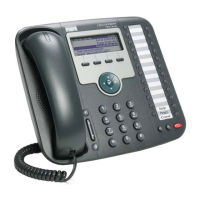4-40
Cisco Unified IP Phone 7931G Administration Guide for Cisco Unified Communications Manager 8.0 (SCCP and SIP)
OL-20798-01
Chapter 4 Configuring Settings on the Cisco Unified IP Phone
Security Configuration Menu
802.1X Authentication and Status
The 802.1X Authentication and 802.1X Authentication Status menus allow you to enable 802.1X
authentication and monitor its progress. These options are described in Table 4-25 and Table 4-26.
You can access these menus from the Settings menu > Security Configuration menu by choosing 802.1X
Authentication or 802.1X Authentication Status.
For instructions about how to access the Security Configuration menu and its submenus, see the
“Displaying a Configuration Menu” section on page 4-2.
Table 4-25 802.1X Authentication Settings
Option Description To Change
Device
Authentication
Determines whether 802.1X authentication is enabled:
• Enabled—Phone uses 802.1X authentication to request
network access.
• Disabled—Default setting in which the phone uses CDP
to acquire VLAN and network access.
1. Choose Settings > Security
Configuration > 802.1X
Authentication > Device
Authentication.
2. Set the Device Authentication option to
Enabled or Disabled.
3. Press the Save softkey.
EAP-MD5 Specifies a password for use with 802.1X authentication
using the following menu options (described in the following
rows):
• Device ID
• Shared Secret
• Realm
Choose Settings > Security Configuration
> 802.1X Authentication > EAP-MD5.
Device ID—Derivative of the phone’s model number and
unique MAC address displayed in this format:
CP-<model>-SEP-<MAC>
Display only—Cannot configure.
Shared Secret—Choose a password to use on the phone and
on the authentication server. The password must be between
6 and 32 characters, consisting of any combination of
numbers or letters.
Note If you disable 802.1X authentication or perform a
factory reset of the phone, the shared secret is
deleted.
1. Choose EAP-MD5 > Shared Secret.
2. Enter the shared secret.
3. Press Save.
For assistance in recovering from a deleted
shared secret, see Troubleshooting Cisco
Unified IP Phone Security, page 9-8.
Realm—Indicates the user network domain, always set as
Network
Display only—Cannot configure.

